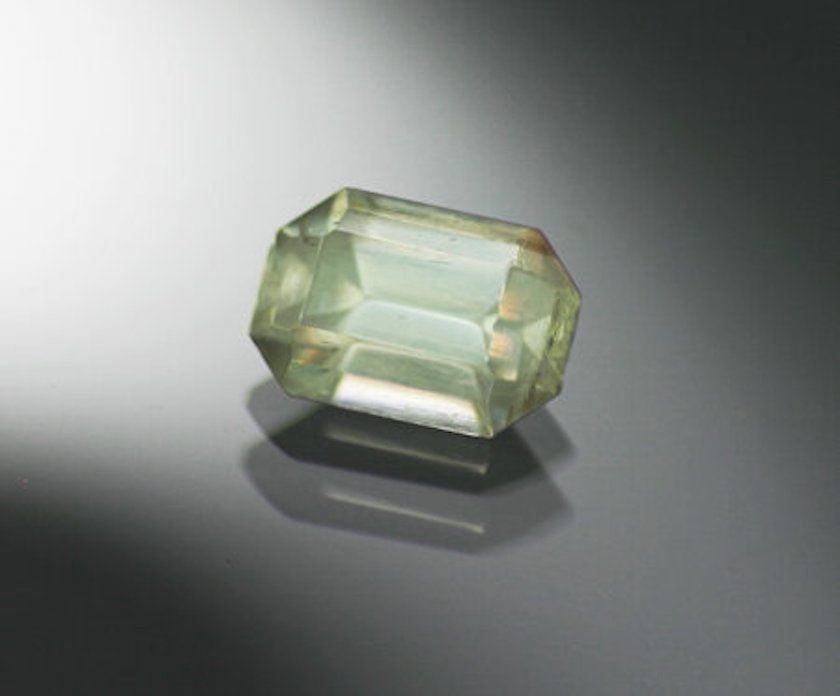Phosgenite Value, Price, and Jewelry Information
Rare phosgenite typically shows pale colors. This material is difficult to cut and too soft for jewelry wear. However, its strong yellowish fluorescence appeals to collectors of unusual gemstones.
2 Minute Read
Rare phosgenite typically shows pale colors. This material is difficult to cut and too soft for jewelry wear. However, its strong yellowish fluorescence appeals to collectors of unusual gemstones.
Start an IGS Membership today
for full access to our price guide (updated monthly).Phosgenite Value
Does Phosgenite Make a Good Jewelry Stone?
Phosgenites contain lead. When cutting this material, avoid ingesting or inhaling particles and wash your hands. For more information, consult our articles on lapidary health hazards and safety tips and toxic and radioactive gems. Since the material is so soft, jewelry use isn't recommended. Keep phosgenites for display only.
Nevertheless, lapidaries can cut massive phosgenite into interesting cabochons of various colors, up to the size of the rough (several inches). However, faceted pieces are more rarely encountered, and not simply because of the material's scarcity or toxicity.
Phosgenites can have directions of variable (and low) hardness (2-3) and distinct to good cleavage. Although this gem can have an adamantine, diamond-like luster, it's also difficult to polish. If you also take into account its flexible and sectile properties, phosgenites simply don't make practical cutting material.
Identifying Phosgenites
While phosgenite usually occurs colorless or in soft shades of yellow, gray, brown, pink, or green, it has a strong yellowish fluorescence under both ultraviolet light (UV) and X-rays. This fluorescence and its relatively high specific gravity (SG) of 6.13 help to distinguish it from stones of similar range and hardness. In fact, phosgenite has a much greater density than two more popular gems with a similar range of colors and hardness: amber (1.08) and mellite (1.64).
However, two other rarely faceted collector's gemstones have a comparable range of colors, hardness, and SG. Like phosgenite, anglesite and cerussite can be colorless as well as white, grayish, yellowish, or greenish. Their fluorescence under UV light can also appear yellowish. Furthermore, these minerals can crystalize in close association.
Comparison of Selected Physical and Optical Properties of Anglesite, Cerussite, and Phosgenite
| Hardness | SG | Fluorescence in UV | Refractive Index | Optic Character | |
| Anglesite | 2.5-3 | 6.30-6.39 | Weak yellowish. | a = 1.877; b = 1.883; γ = 1.894 | Biaxial (+) |
| Cerussite | 3-3.5 | 6.55 | Can be yellow in LW. Pale blue/green in SW. | a = 1.804; b = 2.076; γ = 2.079 | Biaxial (-) |
| Phosgenite | 2-3 | 6.13 | Strong yellowish. | o = 2.114-2.118; e = 2.140-2.145 | Uniaxial (+) |
A refractive index and an optic character reading with a refractometer and/or polariscope may be the most effective way to distinguish these gems. However, keep in mind that phosgenites may be anomalously biaxial. Thick pieces of phosgenite (not all specimens) may have weak pleochroism, while anglesite and cerussite don't.
The yellow fluorescence of this gemmy phosgenite crystal on galena is more marked in its upper centimeter. 4.2 x 3.0 x 3.0 cm. Monteponi Mine, Iglesias, Sardinia, Italy. © Rob Lavinsky, www.iRocks.com. Used with permission.
Are There Synthetic Phosgenites?
Scientists have synthesized phosgenite for various purposes for centuries. In the February 2014 newsletter of the British Micromount Society, Steve Plant describes various manufacturing methods, from the time of the Ancient Egyptians (who used synthetic phosgenite for makeup) through 19th and early 20th century procedures to current techniques.
Although lab-created crystals do exist, there is no known jewelry use for this material.
There are no known gem treatments for phosgenites.
Where is Phosgenite Found?
Monteponi, Sardinia, Italy produces fine, yellow-brown crystals up to 5 inches across, some with facetable areas.
Other notable sources include the following:
- United Kingdom: Matlock and Cromford, Derbyshire, England (type locality).
- United States: Arizona; California; Colorado; Massachusetts; New Mexico.
- Australia; Laurium, Greece;Morocco (some cuttable); Tsumeb, Namibia (some cuttable); Tarnow, Poland; Russia; Tasmania; Tunisia.
Phosgenite Stone Sizes
Rare faceted specimens almost always weigh less than two carats. Typically from Sardinia, these gems usually have a yellowish brown color. However, a few larger stones exist, some up to about 10 carats.
Joel E. Arem, Ph.D., FGA
Dr. Joel E. Arem has more than 60 years of experience in the world of gems and minerals. After obtaining his Ph.D. in Mineralogy from Harvard University, he has published numerous books that are still among the most widely used references and guidebooks on crystals, gems and minerals in the world.
Co-founder and President of numerous organizations, Dr. Arem has enjoyed a lifelong career in mineralogy and gemology. He has been a Smithsonian scientist and Curator, a consultant to many well-known companies and institutions, and a prolific author and speaker. Although his main activities have been as a gem cutter and dealer, his focus has always been education. joelarem.com
International Gem Society
Related Articles
Black Diamond Value, Price, and Jewelry Information
Chameleon Diamond Value, Price, and Jewelry Information
Gray Diamond Value, Price, and Jewelry Information
Green Diamond Value, Price, and Jewelry Information
Latest Articles
Quartz Toxicity: Understanding the Risks for Jewelers and Wearers
Synthetic Amethyst: What is it and How is it Made?
Hambergite Value, Price, and Jewelry Information
Pearl Simulants: How to Spot Faux Pearls
Never Stop Learning
When you join the IGS community, you get trusted diamond & gemstone information when you need it.
Get Gemology Insights
Get started with the International Gem Society’s free guide to gemstone identification. Join our weekly newsletter & get a free copy of the Gem ID Checklist!
